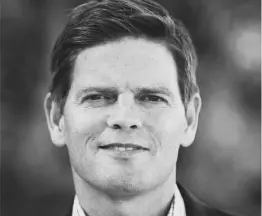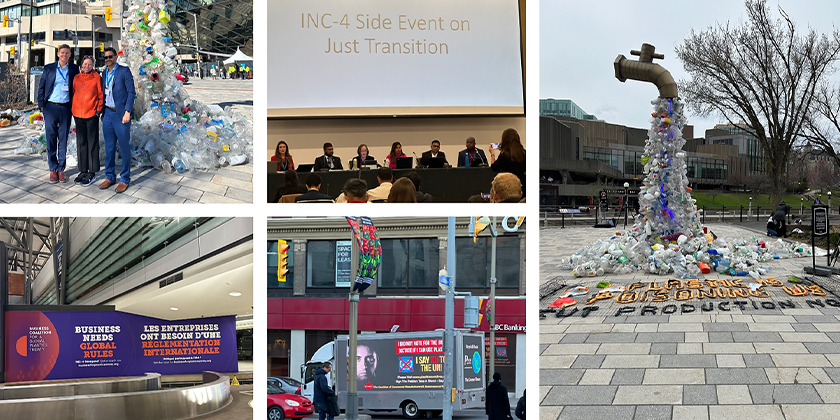Reflections on INC-4: Cautious Optimism on the Path to a Global Plastics Treaty
-

-
Michael Sadowski
-
May 3, 2024
-
5 min read

Michael Sadowski
May 3, 2024
5 min read


In the early morning of April 30th, after seven intense days of negotiations, the fourth session of the Intergovernmental Negotiating Committee (INC-4) to develop a global plastic pollution treaty concluded in Ottawa. The United Nations Environment Programme (UNEP) – the convener of the negotiations – announced an advanced draft text of the treaty and agreement on intersessional work ahead of INC-5 in late November. In my first time observing an international policy negotiation, it seems that agreeing to work in between sessions is a small win. But, as such intersessional work was not agreed after INC-3, this is being viewed as an important victory.
Countries have agreed to conduct formal intersessional work ahead of INC-5 on topics including harmful and avoidable plastic products and chemicals, product design, and financial resources. However, countries did not agree to work on measures to reduce plastic production and consumption, a glaring omission noted by environmental groups, including WWF, Greenpeace, and the Center for International Environmental Law.
Looking back at my time in Ottawa, I came away feeling cautiously optimistic for several reasons:
A clear and consistent voice from business
Walking through baggage claim upon landing in Ottawa and seeing signage from the Business Coalition for a Global Plastics Treaty, it was clear that the private sector was present to advocate for an ambitious and legally-binding treaty. The Coalition created an engaging video on why business needs global rules, the CEO of Unilever shared the Coalition’s main points on Partnerships Day, and company representatives consistently shared the key messages at side sessions and events. I expect the Coalition will continue to expand ahead of INC-5, which is key, as there are influential companies lined up in opposition to the treaty as evidenced by trucks driving around the Shaw Center advertising that “plastic saves lives.”
The informal sector and a just transition were front and center
Due to the tireless work of various individuals and organizations in previous INC meetings and beyond, the informal sector and a “just transition” were high on the agenda. Last year, my colleague Anna wrote about progress made in Nairobi, in which the phrase “waste pickers” was defined and incorporated into the treaty, as was just transition. In Ottawa, I attended three sessions on the informal sector and just transition, including an official side event. I was particularly struck by a response from a waste picker from South America when asked about what a just transition would look like for him. He replied that individuals would not have to wait 40 years to improve their lives like he did (he has picked waste since his pre-teen years), and offered a number of specific interventions including the right to organize, access to technology, and the opportunity to work beyond collection if individuals so choose.
Recycling is a key part of the solution, but we need to level the playing field
In her opening remarks on Partnerships Day, Inger Andersen, Executive Director of UNEP, shared ten critical elements in the plastics treaty, including the need to strengthen recycling – which some have called a false solution. In an ideal world, we could reduce primary production through a combination of new business models (e.g., reuse) and alternative materials. But we are not in that world, and so we will need to invest to improve waste management and recycling infrastructure to deal with the plastic waste that exists today and that will be generated in the future. Much of this investment needs to occur in emerging economies where the plastic pollution crisis is most acute, and where – as the Plastics Circularity Investment Tracker shows – the least amount of investment is occurring.
The investment landscape and market for recycled plastic would be greatly improved if prices for virgin plastic were not at such an advantage compared to recycled plastic – a trend which is likely to continue given the oversupply of chemicals used in plastic production. Given the considerable externalities from virgin plastic production – impacts to climate, human health, biodiversity, and more – virgin plastic should trade at higher prices than recycled.
Considerable financial resources are needed, and an intriguing proposition
Nearly US$17 trillion in public and private investment is needed between 2025 to 2040 to reduce annual mismanaged plastic volumes by 90% relative to 2019 levels. This is a staggering amount, though as Systemiq points out in their new Plastics Treaty Futures report, there are considerable economic, environmental, and health benefits to be gained.
In an intriguing thought exercise, Minderoo Foundation published a paper in which it proposed a fee of US$60 to 90 per tonne on primary plastic production that could generate US$350 to 500 billion. They outline the various impacts of such a fee, including reductions in mismanaged plastic waste entering the environment (90%), primary plastic production (10%), and greenhouse gasses (5%). Such a fee could help level the playing field for virgin and recycled plastic and contribute to supporting a just transition for informal workers. Given the inability of member states to adopt a global price on carbon, this will be a challenge. However, perhaps companies in the Business Coalition could lead the charge in implementing an internal price on plastic similar to what some companies have done with carbon.
I left Ottawa with a sense of cautious optimism that negotiators will roll up their sleeves to address plastics and chemicals of concern and financing ahead of INC-5. Time will tell if the Bridge to Busan effort will attract more signatories to address primary plastic production. In the paraphrased words of Dr. Adil Najam of WWF International, agreeing to the Montreal Protocol was incredibly hard at the time, but looking back, we think it was easy. Anything that is worthwhile is hard, he offered, including aligning on the plastics treaty, but hopefully, one day, we’ll look back and think it was easy.
Endnotes
1. For specific examples, see UNEP’s brief on plastic pollution science